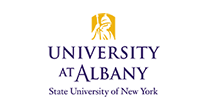News
December 5, 2018Chemistry Major Receives National Recognition
A senior chemistry student at the University at Albany was among a small group nationwide invited to present her research at the Mount Sinai School of Medicine’s Undergraduate Research Symposium. Nana-Hawwa Abdul-Rahman’s work involves seeking an improved method to identify dangerous psychoactive drugs.
Abdul-Rahman, a chemistry major and biology minor, has been working in Professor Rabi Musah’s lab on techniques she hopes will better aid law enforcement and healthcare professionals in quickly identifying potentially deadly mind-altering substances a person has ingested. She won the Outstanding Poster Award, the top prize, at the symposium.
Abdul-Rahman explains that there are a number of psychoactive plant seeds increasingly used by those seeking a legal high. These drugs are “unscheduled,” meaning that even though they are mind-altering, they are not monitored or controlled by law enforcement in the same way substances such as medical marijuana or narcotics are. Some of these psychoactive plants contain atropine and scopolamine – chemicals largely found in prescription drugs. While the purified molecules are regulated, the plants that contain them are not. These plants are toxic and when ingested, can result in psychosis, hallucinations, cardiovascular problems, and even death.
Atropine and scopolamine are legitimate prescription drugs used for reasons such as to regulate a patient’s heartrate during surgery or to stave off motion sickness, respectively. Despite their legitimacy when used properly, individuals wishing to circumvent drug laws ingest the plants that contain these molecules as a means to enter altered states of consciousness. The consequences can be dire, according to Musah.
The challenge, the researchers explain, is that timely and appropriate treatment is dependent on knowing the identity of the drug that was taken.
“Law enforcement or emergency medical technicians will often come upon a scene where the only thing they have to tell them what the person has ingested is an unrecognizable pile of crumbled up seeds and leaves,” Abdul-Rahman says. “This is problematic because when the identity of the psychoactive drugs is unknown, it is more challenging to determine the proper medical treatment, and it can also make identifying substances found at a crime scene nearly impossible.”
To mitigate this, Abdul-Rahman has been using a technique called Direct Analysis in Real Time-High Resolution Mass Spectrometry (DART-HRMS) coupled with multivariate statistical analysis to rapidly identify plant-derived unknowns.
“In Professor Musah’s lab, we’re creating a chemical fingerprint database to enable legal high psychoactive plant material acquired by crime scene investigators and emergency medical technicians to be analyzed and rapidly identified by DART-HRMS. These drugs are really dangerous, and this method could save lives.”
“Nana-Hawwa’s work, funded by a grant from the U.S. National Institute of Justice, is making an important contribution to forensic science practice, and we are in the final stages of drafting a research article that reports the successful application of DART-HRMS to the identification of nightshade family plants that contain scopolamine and atropine,” said Professor Musah.
Abdul-Rahman, who is the vice president of both the Omicron Delta Kappa National Leadership Honor Society and the Muslim Student Association, has presented this research at other symposiums, including the Department of Chemistry’s Undergraduate Research Symposium where she received first-place recognition for her oral presentation. She plans to continue her education after graduation, with her sights set on medical school – a path that will allow her to pursue her mutual love of both research and medicine.
“I can’t imagine my future without research and medicine,” said Abdul-Rahman. “I’m very thankful for mentors like Dr. Musah, who always push me to never give up on my aspirations regardless of the challenges that come with such career choices.”


























